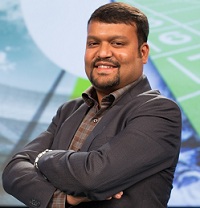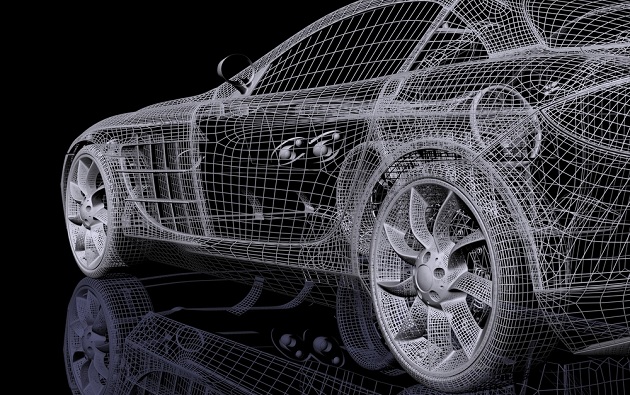Maxim has continued to focus on the automotive segment in areas such as advanced driver assistance systems (ADAS) and high-end infotainment. Meanwhile, empowering design innovation for our automotive, industrial, healthcare, mobile consumer, and cloud data center customers was and is a key focus for Maxim, allowing the customers to deliver industry-leading solutions that help change the world. Devendra Kumar, Editor, ELE Times in an interaction with Sanket B, Director, Sales & Field Applications, India, ASEAN countries, Australia & New Zealand, Maxim Integrated, discusses diverse technologies and its applications as power management, innovations in the field of RF & Microwave, Keyless Access Devices, high–speed communications design, IoT and host of other latest technologies. Excerpts.
ELE Times: Efficient power management is the theme for power ICs in 2018. Please discuss at length about current development in power management ICs (PMICs) in respect to automotive industry.
Sanket B: The number of powered control modules, sensors, actuators, and motors distributed throughout today’s automobiles has increased markedly within the last decade. This has increased the need for more diverse power management and voltage regulation circuits.High-brightness LEDs are now commonly used for automotive applications ranging from headlights to interior lighting to infotainment LCD back lighting. These LEDs are driven by switching and linear voltage regulators that are designed for the specific application.
Maxim offers many types of PMIC, DC-DC converter, and voltage regulator devices for automotive power management and lighting applications, as well as a wide range of LED drivers to reliably regulate the power to LEDs in automotive lighting applications.
Electric, hybrid, and plug-in hybrid vehicles use large lithium-ion (Li+) battery packs for energy storage. These battery packs are constructed of hundreds or even thousands of individual battery cells that must be managed to keep the battery packs in optimal condition and also to optimize their energy storage.
Maxim’s robust battery management solutions offer increased safety when operating the Li+ battery packs while reducing system cost, and they enable ASIL-D safety compliance. With their unique, proprietary daisy-chain architecture and fast SAR ADC, you get fast and accurate measurements. They also function well in noisy vehicle environments, delivering high EMC (Electro Magnetic Compatibility) performance. We offer the industry’s only solution that enables capacitive and transformer isolation. Capacitive isolation allows the replacement of a costly transformer with a capacitor on the battery pack. This approach reduces related bill of materials (BOM) costs by up to 90% and also lowers the failure-in-time (FIT) rate.
ELE Times: What are the latest technologies/ innovations in the field of RF & Microwave? How the technology is about to redefine the concept vehicles of the future?
Sanket B: Traditional radio architecture brings many challenges to vehicle designers. The vehicle’s complex head unit must accommodate multiple tuners, manage heat dissipation, and receive multiple cables from the antennas. In addition, the received analog signals pick up noise as they travel from the antenna to the head unit of the vehicle. Finally, baseband processing uses single purpose hardware, requiring separate designs to support multiple worldwide radio standards.
With Maxim’s remote tuner solution, the RF to Bits tuners are now located in a quieter environment close to the antenna to minimize noise. Meanwhile, the digital outputs of the tuners are serialized using Maxim’s gigabit multimedia serial link (GMSL) serializer and deserializer (SerDes) onto a single low-cost coax cable. Power for the remote tuner solution is also delivered on this single cable. Not only does this improve radio performance, but it also reduces the weight of the vehicle to provide better mileage. Removing all tuners from the head unit saves space and reduces both system complexity and heat dissipation in the head unit.
ELE Times: What technology you are working on ‘Keyless Access Devices’? How do you keep it free from technological vulnerability?
Sanket B: Remote Keyless Entry (RKE) systems offer drivers a way to lock and unlock the vehicle remotely. With traditional RKE systems, the driver presses a key fob button to lock or unlock the car within a certain range, usually up to 300 ft.More advanced RKE systems, such as the “Keyless Go” system, automatically lock the car doors after the driver exits the vehicle, and automatically unlock the vehicle when the driver (with key in pocket) is detected with a certain range upon return.We offer products to support development of both types of remote keyless entry systems.
Maxim provides complete customized keyless-go, long-range, and passive remote keyless entry (PRKE) solutions. Our complete, highly-integrated transmitter and receiver solutions for RKE provide a much longer start-up range than competitive alternatives at a lower system cost. This is due primarily to the 22kHz operating frequency. Our keyless-go products are available as customized solutions for use in high-volume automotive OEM applications and are in production now.
ELE Times: What are the latest developments in hardware and high– speed communications design? How do you optimize signal and power integrity design for the latest DDR and serial link interfaces?
Sanket B: In many of today’s cars, it’s common to find up to eight cameras supporting safety functions. The mix of safety and infotainment will drive future vehicles to have more than a dozen cameras, several high-definition displays, and serial links to transport all of this data. And don’t forget, vehicle-to-vehicle (V2V) and vehicle-to-everything (V2X) communications. Like ADAS and infotainment systems, V2V, V2X, and sensor fusion systems all require high bandwidth and data integrity to enable vehicles to share and act on data from each other as well as roadway infrastructure.According to Strategy Analytics, bandwidth requirements are projected to grow by a factor of roughly 25 from this year to 2020. Higher frame rates and resolutions will only place additional pressure on automotive bandwidth. Yet, this is what’s needed to support the burgeoning volumes of data that online, in-vehicle activities like streamed videos, video conferencing, gaming, and social media will demand. An Ethernet backbone is fairly common in many of today’s cars. It can transport data over a link 100x faster than a CAN bus. However, using Ethernet also requires compression of video feeds, and it simply isn’t fast enough for the requirements of today’s or tomorrow’s vehicles. Car makers increasingly need to be able to transport megapixel resolution images in the vehicle, while also meeting stringent requirements around space and power budget in the cameras.
Maxim’s next-generation GMSL SerDes technology fully supports the high bandwidth, complex interconnect, and data integrity requirements required for future ADAS and infotainment systems. GMSL SerDes technology simultaneously transports HD video, audio, control information, aggregated sensor data, and Gigabit Ethernet over 15m of a single coaxial cable or 10m to 15m of shielded-twisted pair cabling. Since the technology can transport multi-megapixel images without compression, GMSL can support the machine vision technology that’s quickly becoming integral for safety features like object and pedestrian detection. The SerDes technology also features a built-in spread-spectrum capability that reduces electromagnetic interference (EMI) of the link. Requiring only shielded twisted pair or coax cables, GMSL technology simplifies the design while reducing weight, cost, size, and power consumption.
Today’s vehicles are already incorporating more safety and entertainment features that are driving up interface bandwidth demands. Tomorrow’s cars will become remote workstations during the daily commute or entertainment centers on a long road trip, further increasing the need for fast transport and processing of multiple data types. GMSL SerDes technology paves the way for 4K video, sensor data aggregation, Gigabit Ethernet, and audio, helping you design smarter, safer cars for the future.
In January 2018, Maxim started to collaborate with NVIDIA to support the industry’s first Level 5 full-autonomy system, the NVIDIA DRIVE Pegasus platform, as well as the NVIDIA DRIVE Xavier for Level 4 driving. Maxim’s Automotive Safety Integrity Level (ASIL) solutions and high-performance analog integration, which include next-generation GMSL SerDes technology, as well as a power system monitoring solution, provide the flexible foundation necessary to meet functional safety requirements for NVIDIA’s autonomous driving platform.
ELE Times: There is an ever-going technological shift in electronic components innovation? Where does Maxim see itself in this innovation scenario?
Sanket B: Maxim is delivering on our goal to develop innovative analog and mixed-signal products and technologies to make systems smaller and smarter, with enhanced security and increased energy efficiency. Sticking to spend our efforts on developing products and empowering design innovation that always meet our customers’ needs, this is what makes Maxim grow atthe turning point of technology.
Maxim is enabling a safer, smarter car of the future with the MAX17843 battery management system (BMS). The MAX17843 12-channel, high-voltage smart sensor data-acquisition device, which is a single-chip solution to achieve ASIL-D compliance, enabling automotive OEMs to enhance the safety of their lithium-ion battery packs with robust communications, comprehensive diagnostics, and lower system costs.
ELE Times: How is Maxim geared-up to be a part of an IoT-driven world, with everyone and everything being connected to the electronic devices?
Sanket B: Gartner forecasts that by 2020, we’ll have 20.8 billion connected things in the world. IoT electronics are represented by a broad collection of niche markets, where products typically:
- Span diverse vertical industries
- Have life spans ranging from a few days to decades
- Output data ranging from a few bits to terabytes
- Feature different levels of complexity, from simple controller-based fitness monitors to complex, integrated industrial systems
At Maxim, we see IoT as an opportunity for you to solve problems in new and better ways. We deliver technologies that help you create innovative solutions. From a design perspective, smart, connected things commonly require sensing, processing, communication, power, and security—all areas where Maxim can help.
ELE Times: With its well spread spectrum of products and technological applications, we would like to know about the key areas in which Maxim is mostly involved and has a fair share of the market?
Sanket B: Maxim has continued to focus on the automotive segment in areas such as advanced driver assistance systems (ADAS) and high-end infotainment. Meanwhile, empowering design innovation for our automotive, industrial, healthcare, mobile consumer, and cloud data center customers was and is a key focus for Maxim, allowing our customers to deliver industry-leading solutions that help change the world.

Maxim Integrated








